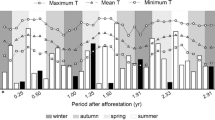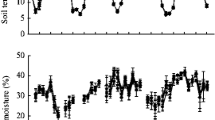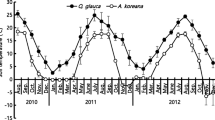Abstract
Background and Aims
Tree species composition shifts can alter soil CO2 and N2O effluxes. We quantified the soil CO2 and N2O efflux rates and temperature sensitivity from Pyrenean oak, Scots pine and mixed stands in Central Spain to assess the effects of a potential expansion of oak forests.
Methods
Soil CO2 and N2O effluxes were measured from topsoil samples by lab incubation from 5 to 25 °C. Soil microbial biomass and community composition were assessed.
Results
Pine stands showed highest soil CO2 efflux, followed by mixed and oak forests (up to 277, 245 and 145 mg CO2-C m−2 h−1, respectively). Despite contrasting soil microbial community composition (more fungi and less actinomycetes in pine plots), carbon decomposability and temperature sensitivity of the soil CO2 efflux remain constant among tree species. Soil N2O efflux rates and its temperature sensitivity was markedly higher in oak stands than in pine stands (70 vs. 27 μg N2O-N m−2 h−1, Q10, 4.5 vs. 2.5).
Conclusions
Conversion of pine to oak forests in the region will likely decrease soil CO2 effluxes due to decreasing SOC contents on the long run and will likely enhance soil N2O effluxes. Our results present only a seasonal snapshot and need to be confirmed in the field.






Similar content being viewed by others
References
Allison SD, Wallenstein MD, Bradford MA (2010) Soil-carbon response to warming dependent on microbial physiology. Nat Geosci 3:336–340
Alvarez S, Ortiz C, Díaz-Pinés E, Rubio A (2014) Influence of tree species composition, thinning intensity and climate change on carbon sequestration in Mediterranean mountain forests: a case study using the CO2Fix model. Mitig Adapt Strateg Glob Change. doi:10.10007/s11027-014-9565-4
Anderson TH, Domsch KH (2010) Soil microbial biomass: the eco-physiological approach. Soil Biol Biochem 42:2039–2043
Bellamy PH, Loveland PJ, Bradley RI, Lark RM, Kirk GJD (2005) Carbon losses from all soils across England and Wales 1978–2003. Nature 437:245–248
Brookes PC, Landman A, Pruden G, Jenkinson DS (1985) Chloroform fumigation and the release of soil-nitrogen - a rapid direct extraction method to measure microbial biomass nitrogen in soil. Soil Biol Biochem 17:837–842
Butterbach-Bahl K, Díaz-Pinés E, Dannenmann M (2012) Soil trace gas emissions and climate change. In: Freedman B (ed) Global environmental change. Springer Verlag, Berlin
Conrad R (1996) Soil microorganisms as controllers of atmospheric trace gases (H-2, CO, CH4, OCS, N2O, and NO). Microbiol Rev 60:609–640
Cox PM, Betts RA, Jones CD, Spall SA, Totterdell IJ (2000) Acceleration of global warming due to carbon-cycle feedbacks in a coupled climate model. Nature 408:184–187
Davidson EA, Janssens IA (2006) Temperature sensitivity of soil carbon decomposition and feedbacks to climate change. Nature 440:165–173
Díaz-Pinés E, Schindlbacher A, Pfeffer M, Jandl R, Zechmeister-Boltenstern S, Rubio A (2010) Root trenching: a useful tool to estimate autotrophic soil respiration? A case study in an Austria mountain forest. Eur J For Res 125:101–109
Díaz-Pinés E, Rubio A, Montes F (2011a) Aboveground soil C inputs in the ecotone between Scots pine and Pyrenean oak in Sierra de Guadarrama. Forest Syst 20:485–495
Díaz-Pinés E, Rubio A, Van Miegroet H, Montes F, Benito M (2011b) Does tree species composition control soil organic matter pools in Mediterranean mountains? Forest Ecol Manag 262:1895–1904
Dix NJ, Webster J (1995) Fungal ecology. Chapman & Hall, London
Fang C, Smith P, Moncrieff JB, Smith JU (2005) Similar response of labile and resistant soil organic matter pools to changes in temperature. Nature 433:57–59
FAO (2006) World Reference Base for Soil Resources 2006, first update 2007. World Soil Resources Reports, n° 103. Food and Agriculture Organization of the United Nations, Rome
Feng X, Simpson MJ (2009) Temperature and substrate controls on microbial phospholipid fatty acid composition during incubation of grassland soils contrasting in organic matter quality. Soil Biol Biochem 41:804–812
Fontaine S, Bardoux G, Abbadie L, Mariotti A (2004) Carbon input to soil may decrease soil carbon content. Ecol Lett 7:314–320
Fontaine S, Barot S, Barre P, Bdioui N, Mary B, Rumpel C (2007) Stability of organic carbon in deep soil layers controlled by fresh carbon supply. Nature 450:277–280
Frostegård A, Tunlid A, Bååth E (1991) Microbial biomass measured as total lipid phosphate in soils of different organic content. J Microbiol Meth 14:151–163
Frostegård A, Bååth E, Tunlid A (1993) Shifts in the structure of soil microbial communities in limed forests as revealed by phsopholipid fatty acid analysis. Soil Biol Biochem 25:723–730
Galiano L, Martinez-Vilalta J, Lloret F (2010) Drought-induced multifactor decline of Scots pine in the Pyrenees and potential vegetation change by the expansion of Co-occurring Oak species. Ecosystems 13:978–991
Gershenson A, Bader NE, Cheng W (2009) Effects of substrate availability on the temperature sensitivity of soil organic matter decomposition. Glob Change Biol 15:176–183
Grogan DW, Cronan JE Jr (1997) Cyclopropane ring formation in membrane lipids of bacteria. Microbiol Mol Biol Rev 61:429–441
Hackl E, Pfeffer M, Donat C, Bachmann G, Zechmeister-Boltenstern S (2005) Composition of the microbial communities in the mineral soil under different types of natural forest. Soil Biol Biochem 37:661–671
IPCC (2013) Climate Change 2013: The Physical Science Basis. Contribution of Working group I to the Fifth Assessment Report of the Intergovernmental Panel on Climate Change. Cambridge University Press, Cambridge
Karhu K, Fritze H, Tuomi M, Vanhala P, Spetz P, Kitunen V, Liski J (2010) Temperature sensitivity of organic matter decomposition in two boreal forest soil profiles. Soil Biol Biochem 42:72–82
Kirschbaum MU (1995) The temperature dependence of soil organic matter decomposition, and the effect of global warming on soil organic C storage. Soil Biol Biochem 6:753–760
Kirschbaum MU (2006) The temperature dependence of organic-matter decomposition - still a topic of debate. Soil Biol Biochem 38:2510–2518
Knorr W, Prentice IC, House JI, Holland EA (2005) Long-term sensitivity of soil carbon turnover to warming. Nature 433:298–301
Kroppenstedt RM (1985) Fatty acid and menaquinon analysis of actinomycetes and related organisms. In: Goodfellow M, Minnikin DE (eds) Chemical methods in bacterial systematics. Academic Press, London, pp 173–199
Lavigne MB, Foster RJ, Goodine G (2004) Seasonal and annual changes in soil respiration in relation to soil temperature, water potential and trenching. Tree Physiol 42:415–424
Lefèvre R, Barré P, Moyano FE, Christensen BT, Bardoux G, Eglin T, Girardin C, Houot S, Kätterer T, van Oort F, Chenu C (2014) Higher temperature sensitivity for stable than for labile soil organic carbon - Evidence from incubations of long-term bare fallow soils. Glob Change Biol 20:633–640
Leifeld J, Fuhrer J (2005) The temperature response of CO2 production from bulk soils and soil fractions is related to soil organic matter quality. Biogeochemistry 75:433–453
Liski J, Ilvesniemi H, Mäkelä A, Westman CJ (1999) CO2 emissions from soil in response to climatic warming are overestimated: the decomposition of old soil organic matter is tolerant to temperature. Ambio 28:171–174
Lloyd J, Taylor JA (1994) On the temperature dependence of soil respiration. Funct Ecol 8:315–323
Menyailo OV, Hungate B (2005) Tree species effects on potential production and consumption of carbon dioxide, methane and nitrous oxide: the Siberian afforestation experiment. In: Binkley D, Menyailo O (eds) Tree species effects on soils: implications for global change. Springer, Dordrecht, pp 293–305
Öhlinger R (1995) Ninhydrin-reactive N by fumigation-extraction technique. In: Schinner F, Öhlinger R, Kandeler E, Margesin R (eds) Methods in soil biology. Springer, Berlin, pp 60–62
Olsen HR, Van Miegroet H (2010) Factors affecting carbon dioxide release from forests and rangeland soils in northern Utah. Soil Sci Soc Am J 74:282–291
Olsson PA (1999) Signature fatty acids provide tools for determination of the distribution and interactions of mycorrhizal fungi in soil. FEMS Microbiol Ecol 29:303–310
Papen H, Rosenkranz P, Butterbach-Bahl K, Gasche R, Willibald G, Brüggemann N (2003) Effects of tree species on C- and N- cycling and biosphere-atmosphere exchange of trace gases in forests. In: Binkley D, Menyailo O (eds) Tree species effects on soils: implications for global change. Springer, Dordrecht, pp 165–172
Pennanen T, Liski J, Bååth E, Kitunen V, Uotila J, Westman CJ, Fritze H (1999) Structure of the microbial communities in coniferous forest soils in relation to site fertility and stand development stage. Microbiol Ecol 38:168–179
Pilegaard K, Skiba U, Ambus P, Beier C, Brüggemann N, Butterbach-Bahl K, Dick J, Dos Santos J, Eash NS, Gallardo A, Gasche R, Horvath L, Kitzler B, Leip A, Pihlatie M, Rosenkranz P, Seufert G, Vesala T, Westrate H, Zechmeister-Boltenstern S (2006) Factors controlling regional differences in forest soil emissions of nitrogen oxides (NO and N2O). Biogeosciences 3:651–661
Priha O, Grayston SJ, Hiukka R, Pennanen T, Smolander A (2001) Microbial community structure and characteristics of the organic matter in soils under Pinus sylvestris, Picea abies and Betula pendula at two forest sites. Biol Fert Soils 33:17–24
Ritz K, Wheatley RE (1989) Freezing as a means of preserving samples in soil respiration studies. Biol Fert Soils 8:95–96
Rovira P, Vallejo VR (1997) Organic carbon and nitrogen mineralization under mediterranean climatic conditions: the effects of incubation depth. Soil Biol Biochem 29:1509–1520
Rovira P, Jorba M, Romanyà J (2010) Active and passive organic matter fractions in Mediterranean forest soils. Biol Fert Soils 46:355–369
Rubio A, Gavilán RG, Montes F, Gutiérrez-Girón A, Díaz-Pinés E, Mezquida ET (2011) Biodiversity measures applied to stand-level management: can they really be useful? Ecol Indic 11:545–556
Schaufler G, Kitzler B, Schindlbacher A, Skiba U, Sutton MA, Zechmeister-Boltenstern S (2010) Greenhouse gas emissions from European soils under different land use: effects of soil moisture and temperature. Eur J Soil Sci 61:683–696
Schimel JP, Gulledge J (1998) Microbial community structure and global trace gases. Glob Change Biol 4:745–758
Schindlbacher A, Zechmeister-Boltenstern S, Kitzler B, Jandl R (2008) Experimental forest soil warming: response of autotrophic and heterotrophic soil respiration to a short-term 10° C temperature rise. Plant Soil 303:323–330
Schindlbacher A, de Gonzalo C, Diaz-Pines E, Gorria P, Matthews B, Inclan R, Zechmeister-Boltenstern S, Rubio A, Jandl R (2010) Temperature sensitivity of forest soil organic matter decomposition along two elevation gradients. J Geophys Res 115, G03018
Schindlbacher A, Rodler A, Kuffner M, Kitzler B, Sessitsch A, Zechmeister-Boltenstern S (2011) Experimental warming effects on the microbial community of a temperate mountain forest soil. Soil Biol Biochem 43:1417–1425
Singh BK, Bardgett RD, Smith P, Reay DS (2010) Microorganisms and climate change: terrestrial feedbacks and mitigation options. Nat Rev Microbiol 8:779–790
Stenberg B, Johansson M, Pell M, Sjödahl-Svensson K, Stenström J, Torstensson L (1998) Microbial biomass and activities in soil as affected by frozen and cold storage. Soil Biol Biochem 30:393–402
Vesterdal L, Elberling B, Christiansen JR, Callesen I, Schmidt IK (2012) Soil respiration and rates of soil carbon turnover differ among six common European tree species. Forest Ecol Manag 264:185–196
Zechmeister-Boltenstern S, Michel K, Pfeffer M (2011) Soil microbial community structure in European forests in relation to forest type and atmospheric nitrogen deposition. Plant Soil 343:37–50
Acknowledgments
Authors are grateful to Nicolás Elizalde for his laboratory work. We thank Tommaso Chiti and three anonymous referees for their valuable comments to the manuscript. This work was partially funded by the Projects AGL2010-16862/FOR from the Spanish Ministry of Science and Innovation and P2009/AMB-1478 from the Community of Madrid.
Author information
Authors and Affiliations
Corresponding author
Additional information
Responsible Editor: Ute Skiba.
Rights and permissions
About this article
Cite this article
Díaz-Pinés, E., Schindlbacher, A., Godino, M. et al. Effects of tree species composition on the CO2 and N2O efflux of a Mediterranean mountain forest soil. Plant Soil 384, 243–257 (2014). https://doi.org/10.1007/s11104-014-2200-z
Received:
Accepted:
Published:
Issue Date:
DOI: https://doi.org/10.1007/s11104-014-2200-z




